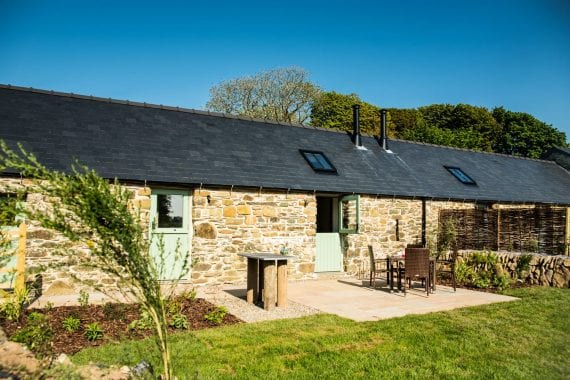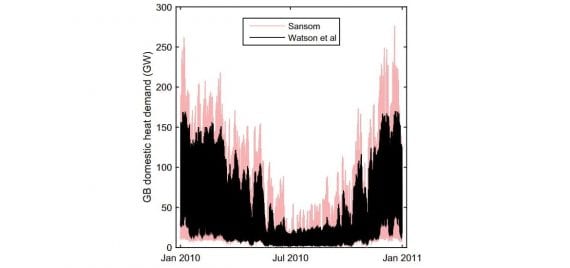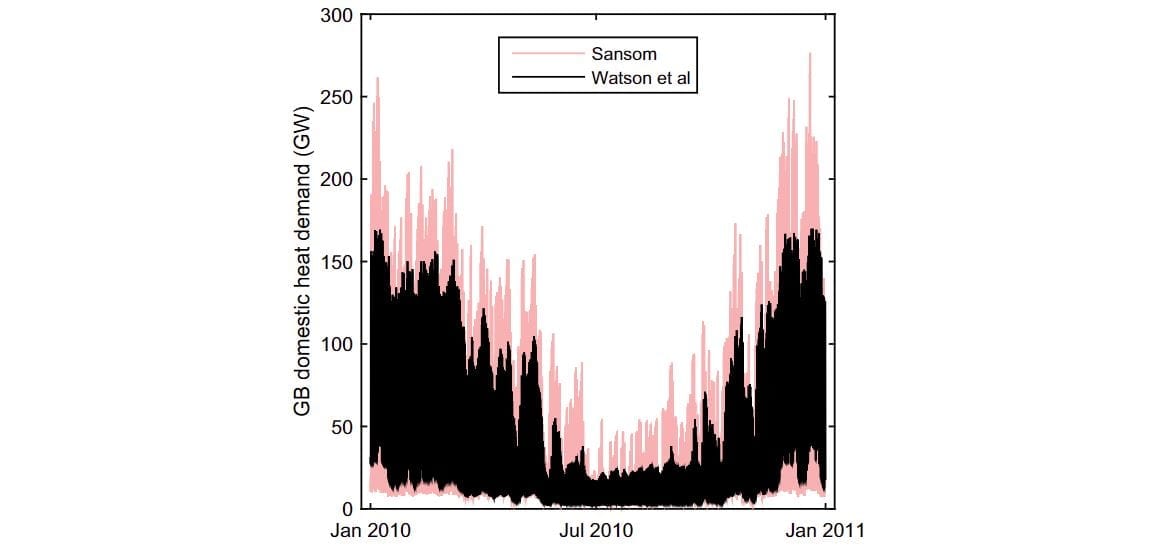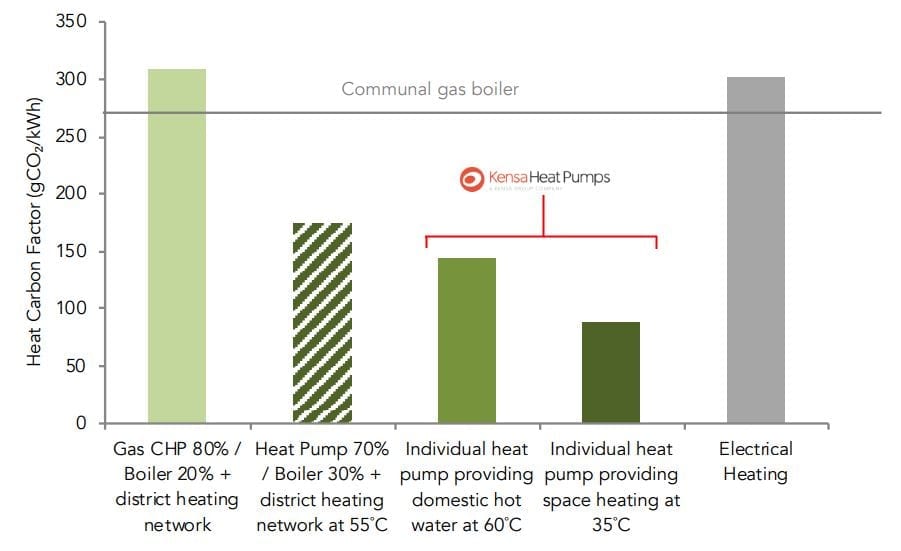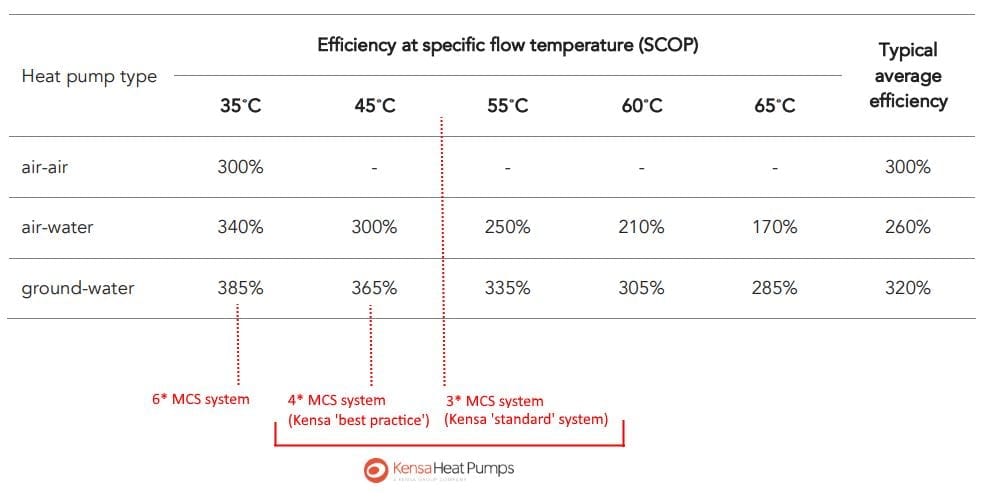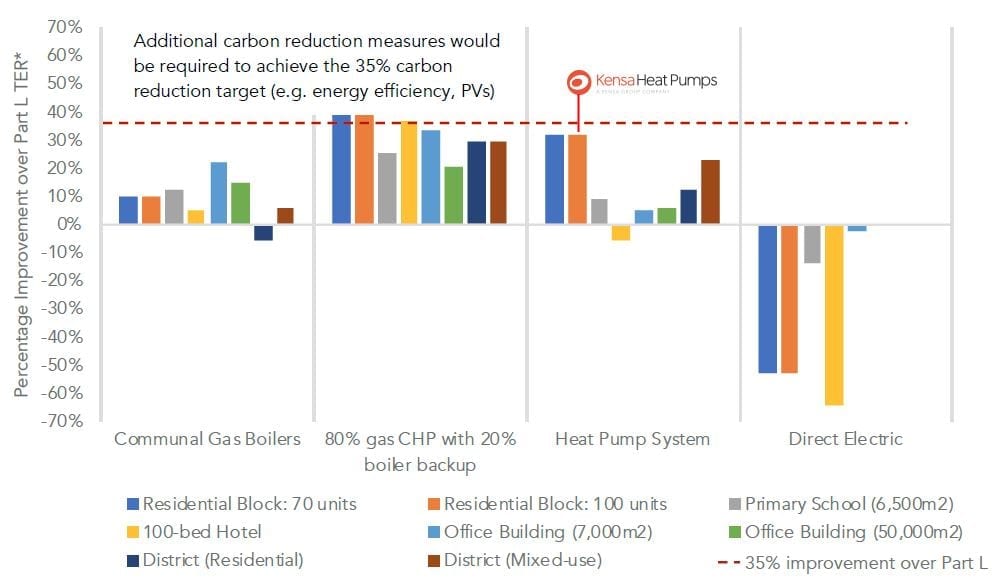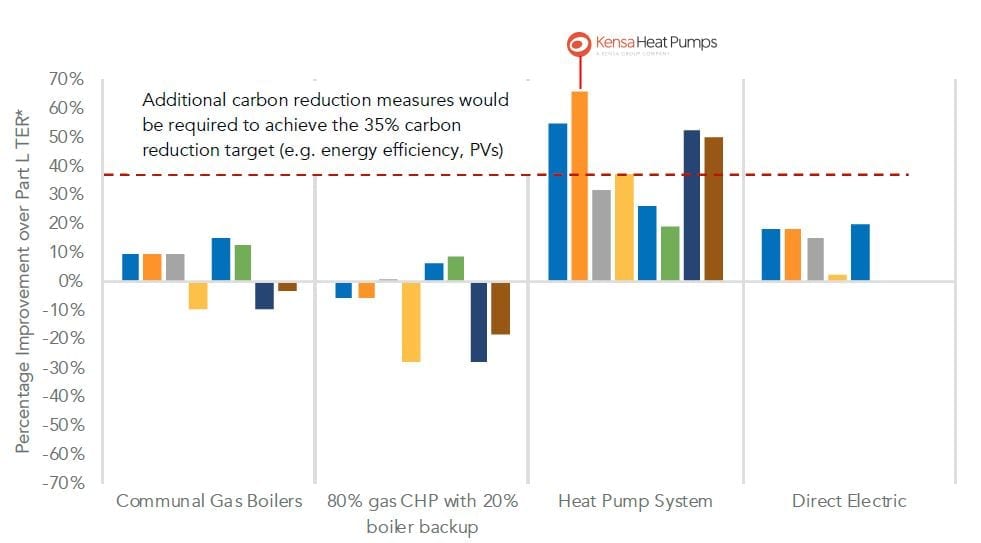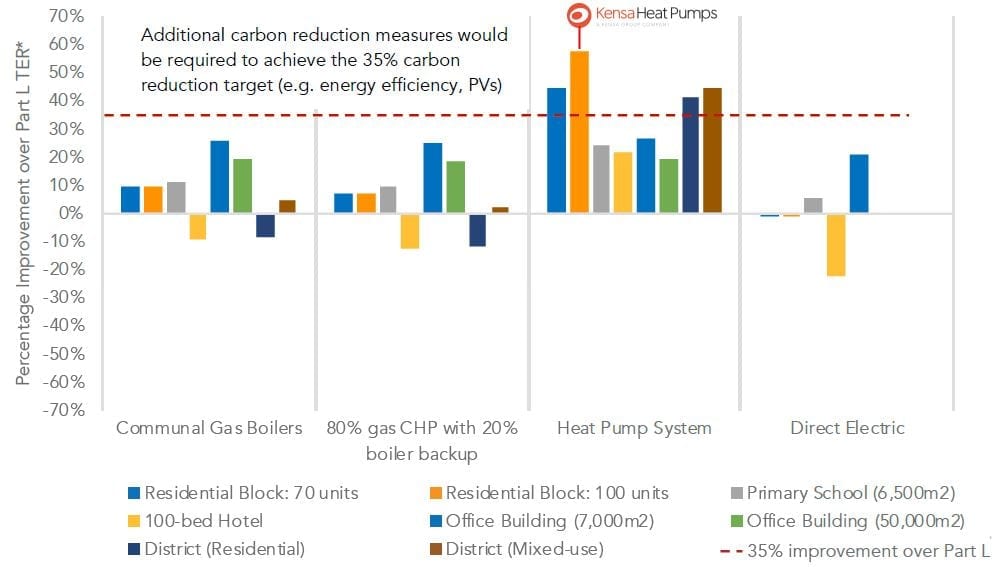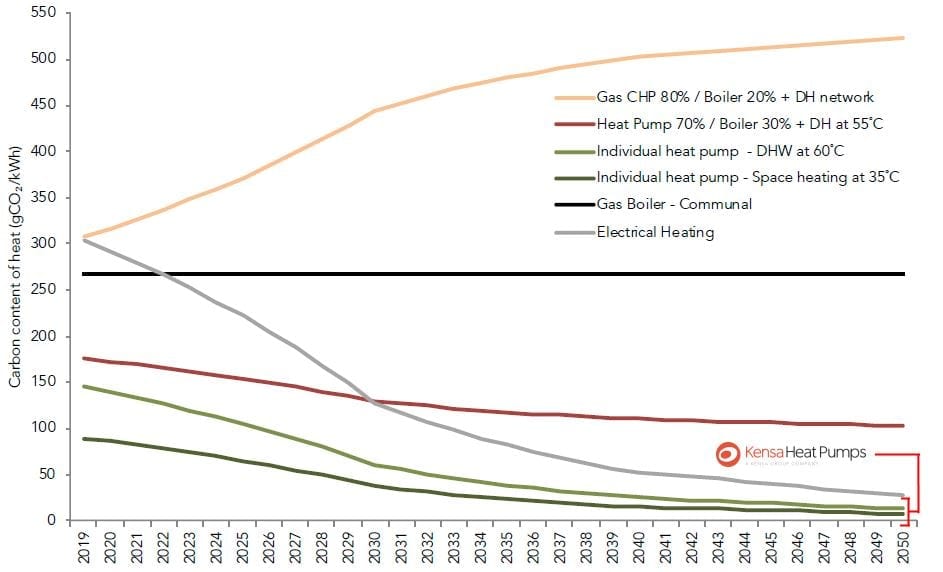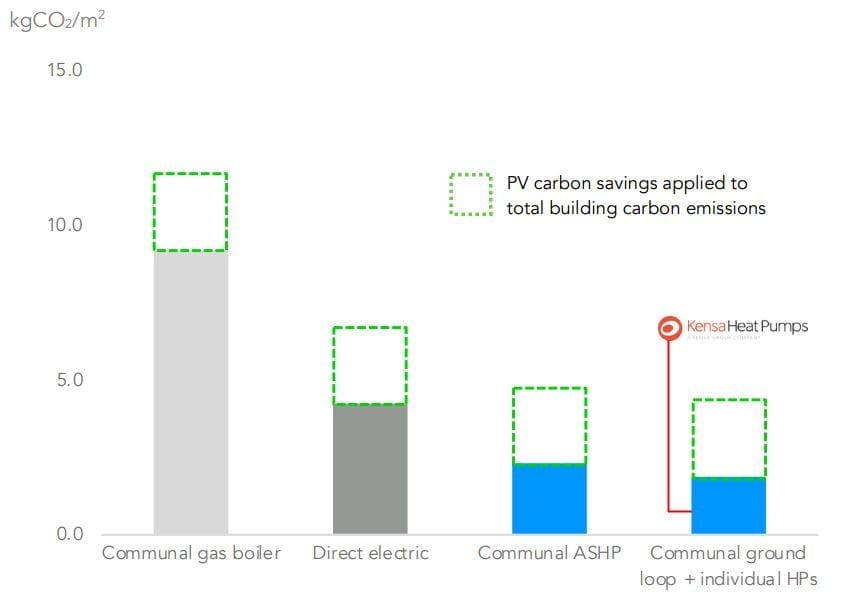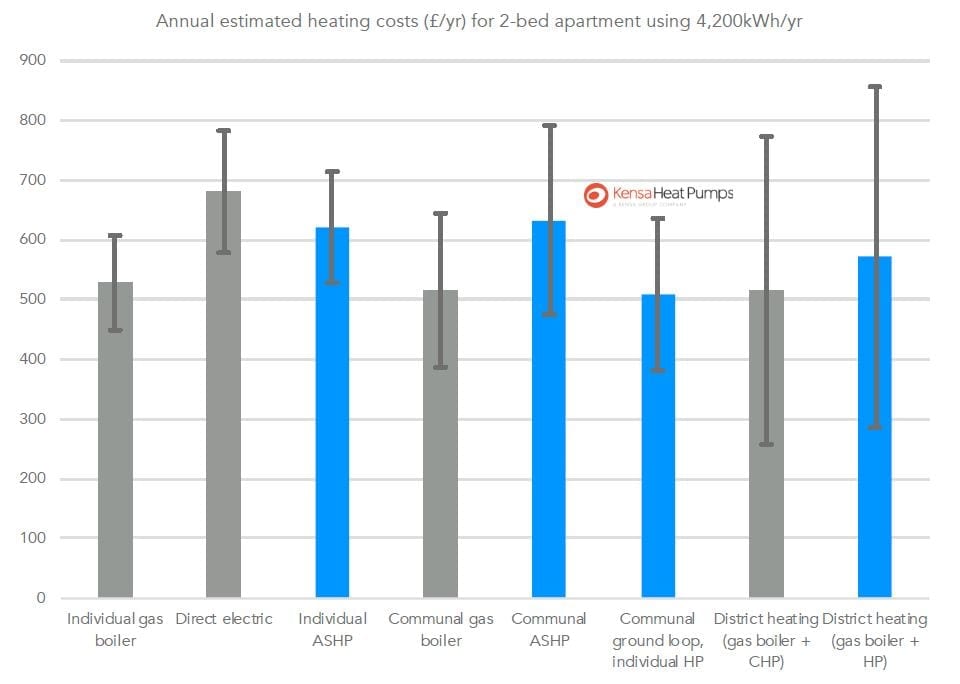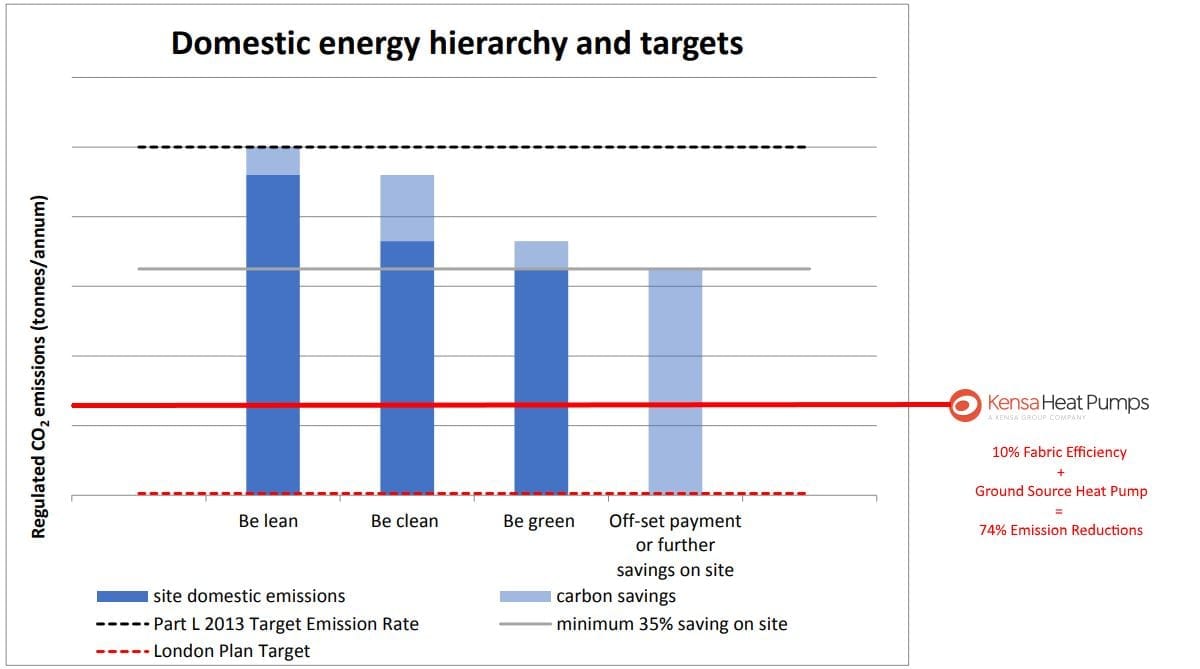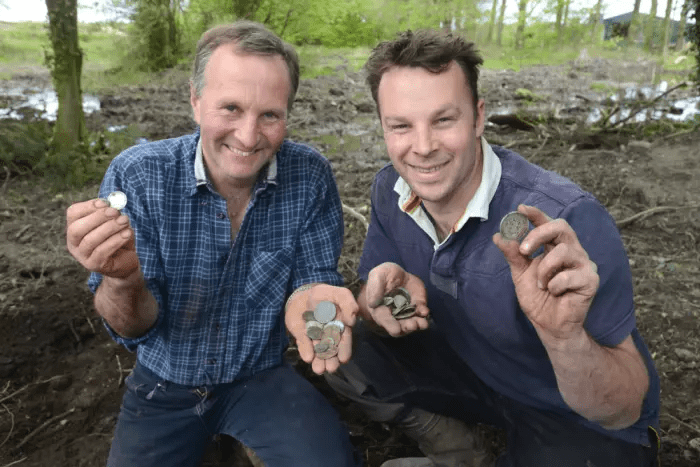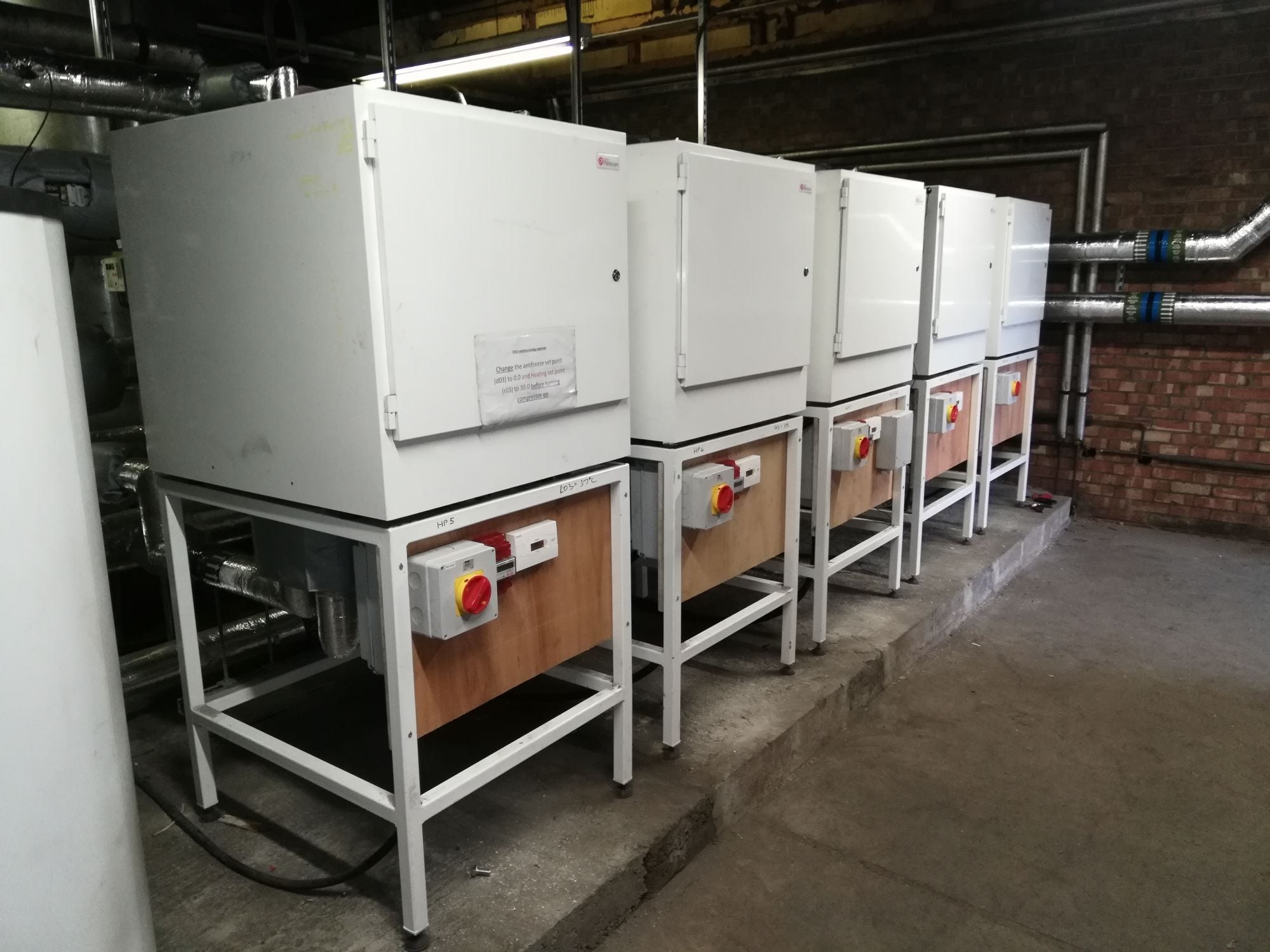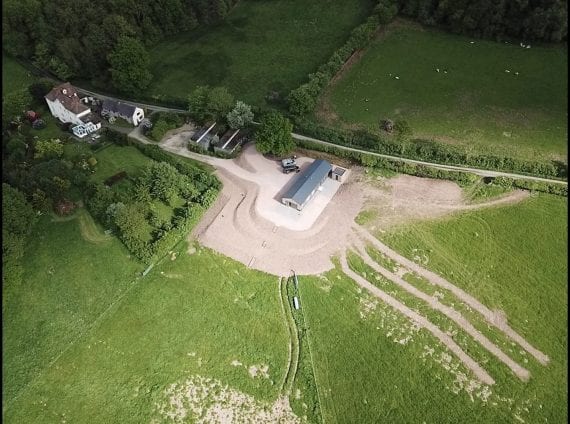How to be carbon compliant for less
- GLA heat pumps report identifies shared ground loop arrays with individual ground source heat pumps as the lowest carbon & lowest cost solution for heating new builds
- Carbon pollution must be reduced to zero by 2050 to limit global warming
- At the same time house building to increase by 300,000 every year to 2020
- Homes and workplaces in London account for 78% of its emissions
- UK cities taking action to be zero-carbon by 2050 – some even earlier
- London developers to build to SAP10 emission factors from January 2019
Disproportionate housing demand in the UK has led to Government committing to delivering 300,000 homes a year by the mid-2020s.
Simultaneously, alarming reports from the world’s leading climate scientists have outlined that there are only a dozen years to keep global warming to a maximum of 1.5°C; we are currently on course for a 3°C rise, of which the consequent droughts, storms and sea-level rises are said to be irreversible.
To achieve this, carbon pollution would have to be cut by 45% below 2010 levels by 2030 and come down to zero by 2050, by which point the use of fossil fuels should also be phased out.
Add to this the Clean Air Strategy’s ambition to reduce particulate matter emissions by 30% by 2020 and 46% by 2030, and the pressure to deliver low carbon, low polluting, new build homes has significant long term impacts on health and the environment now and in the future.
Capital costs: The scale of carbon pressures in our cities
Major UK cities are starting to take urgent ‘game-changing’ action to reduce carbon, and ultimately become carbon neutral. Many cities are scaling up their ambitions to such a degree they aim to surpass the targets set in the 2015 Paris Agreement.
Indeed, Manchester City Council recently announced a speeding up of its zero carbon city ambitions, increasing CO2 reductions from 9% to 13% annually to become zero carbon by 2038, well in advance of the previous commitment to achieve this goal by 2050.
Following suit, Bristol has also adopted a ‘game-changing ambition of becoming a carbon neutral city by 2030’.
London is responsible for 8% of the UK’s GHG emissions. Homes and workplaces in the capital account for approximately 78% of its greenhouse gas emissions. To deliver its ambitions to be a zero-carbon city by 2050, Policy SI2 of the new draft London Plan explicitly focusses on cutting emissions from buildings, pledging ‘major development should be net zero-carbon’.
This objective has been reinforced by London joining 18 other mayors of cities including Los Angeles and Paris by signing the Net Zero Carbon Buildings Declaration, to introduce planning regulations that will require all signatories to ensure new buildings in their cities operate at net-zero carbon by 2030 and all buildings by 2050.
Indeed, to meet this objective Mayor Sadiq Khan said he would expand the existing standard of zero-carbon new homes to apply to all new buildings in 2019.
To achieve their zero carbon commitments, all new developments in London must achieve an on-site carbon reduction of at least 35% beyond the Target Emission Rate (TER). This percentage will increase over time in order to achieve the zero-carbon London ambition and reflect the cost of more efficient construction methods.
The new Draft London Plan goes a step further, stating 10% of the 35% target should be met through energy efficiency measures alone, encouraging a sensible fabric first approach.
As further impetus for ultra-efficient builds, any residual CO2 emissions are to be offset and paid for by the developer at a suggested rate of £95/tonne, which is utilised by carbon offset funds for further energy efficiency improvements in London boroughs.
To support initiatives to improve London’s local air quality and emissions (read Kensa’s blog here), and inform the implementation of the Draft London Plan policies and London Environment Strategy publication, the Greater London Authorities (GLA) commissioning of the report ‘Low Carbon Heat: Heat Pumps In London’ outlines how developers in London can comply with the increasingly stringent targets with an informed specification of low-carbon heating system.
70% CO2 savings – gas pipe dream, shared ground array reality
To cost-effectively develop the tens of thousands of sustainable homes required, a solution in the form of ground source heat pumps with Shared Ground Loop Arrays is coming to the fore, offering the lowest carbon emissions and running cost savings. The result is a transformed and future-proofed clean heating infrastructure to rival and replace the gas network.
The combination of carbon and running cost savings of ground source heat pumps with shared ground loop arrays has been thoroughly documented within the GLA’s commissioned report by Etude, ‘Low Carbon Heat: Heat Pumps In London’.
The report shows shared ground loop array installations, defined by Etude as a ‘communal ground loop connected to individual heat pumps’, as ‘the most efficient and lowest cost solution compared to various air source, direct electric and gas configurations’. The report continues:
The communal ground loop with individual heat pumps appears to be the most economic solution of all (at approximately £500/yr) and is also compliant with London’s key objectives in terms of air quality and carbon emissions. It combines several advantages: it is very energy efficient and does not require dedicated heat metering and billing.
As non-combustion systems, ground source heat pumps emit no point of use CO2 emissions, nor any pollution for that matter. However building regulations and SAP take into account the carbon intensity and emissions of what is powering the heating system, in ground source heat pumps case, electricity.
As a highly efficient form of heating – delivering 3-4kW of heat for every 1kW of electrical energy used to power the pump – ground source heat pumps offer an ultra-low carbon solution.
Just how ‘low-carbon’ a shared ground loop ground source heat pump system is compared to other heating alternatives is dependent on the carbon factors assumed for each energy source.
The Carbon Factor
Building regulations require CO2 emissions of a new development, the ‘Dwelling Emission Rate’ (DER), to be below the ‘Target Emission Rate’ (TER), the emissions of a notional building of the same size and shape as the development; the target rate is set within the current Standard Assessment Procedure (SAP) in Part L of the Building Regulations.
Currently carbon factors used in Part L are based on those in SAP2012. Using the current electricity related carbon emissions in SAP2012 for electricity at 519gCO2/kWh, Kensa’s shared ground loop array ground source heat pump system operating at 320% efficiency (an efficiency determined in Etude’s report based on a range of data sources) produces a carbon saving of 36.9% compared to a gas combi boiler.
The proposed next version of SAP (SAP 10) reduces the figure of electricity related carbon emissions to 233gCO2/kWh, similar to those of gas, due to the increasing decarbonisation of the electricity grid with clean, renewable energy sources such as wind and solar PV replacing the burning of coal. Thanks to ground source heat pumps efficiencies, by more than halving the CO2 emission factors for electricity in SAP10 the carbon saving for ground source compared to a gas combi boiler would be 70.9%.
To better reflect the actual carbon emissions of a new development in the city, and pre-empt the publication of the new Building Regulations Approved Document L (expected 2019/2020), all new planning applicants in London are to use the SAP10 emission factors as of January 2019, with strong justifications including air quality assessments should developers choose to use the SAP2012 standards instead.
Therefore under SAP10 developments featuring gas CHP will not achieve the carbon savings they have to date. This is of particular concern to developers in London who are required to use SAP10 as of January 2019; their developments featuring gas CHP will need to use significant additional technologies to meet the 35% onsite carbon-reduction target.
SAP2012:

SAP2012 comparison of Part L improvement results (assuming a carbon factor of 519gCO2 /kWh for electricity).
Source: Etude, ‘Low Carbon Heat: Heat Pumps In London’, September 2018.
SAP10:

SAP10 comparison of Part L improvement results (assuming a carbon factor of 233gCO2 /kWh for electricity).
Source: Etude, ‘Low Carbon Heat: Heat Pumps In London’, September 2018.
Careful consideration of how a development is to be heated could save developments several tonnes of CO2 and also tons of money in offset funds, too.
As the UK grid becomes increasingly decarbonised, as is Government’s ambition, the carbon savings of electricity and therefore ground source heat pumps will become even greater, as Etude’s report affirms:
Heat pumps offer an immediate and significant reduction in the carbon content of heat today and this advantage increases substantially in the future as the electricity grid decarbonises.
Indeed, the report notes that increasing grid decarbonisation is responsible for even greater disparity between heating system’s carbon factors, notably in the case of gas fired CHP as highlighted in the graph taken from Etude’s report below.

Projected carbon factor of heat based on HM Treasury Green Book marginal emission factors.
Source: Etude, ‘Low Carbon Heat: Heat Pumps In London’, September 2018.
The Government is also assessing how often carbon emissions are updated in SAP, as the current four year period doesn’t reflect the rate of grid decarbonisation.
Lowering the cost of carbon compliance
The impact of changing carbon factors means the cost to comply with emissions reduction targets increases for developers who traditionally specified gas, in particular gas CHP, whilst it becomes cheaper for those specifying heat pumps.
For developers in London using SAP10 figures and the Draft London Plan’s proposed minimum 10% fabric efficiency measures, the simplest and cheapest way to achieve carbon compliance is to specify a ground source heat pump alongside the minimum energy efficiency measure requirements. By simply coupling the 10% energy efficiency measure improvements with a ground source heat pump, a development’s emissions would be reduced by 74%, leaving just 26% to be offset.

Using SAP10 ground source heat pumps coupled with the minimum 10% fabric efficiency measures under the Draft London Plan could reduce emissions by 74%, substantially more than the 35% minimum TER reductions required for London developments, significantly reducing the residual carbon to be offset.
Source: Greater London Authority, ‘Energy Assessment Guidance’, October 2018.
For a best practice scenario, developments featuring 10% fabric efficiencies plus 25% additional energy efficiency measures such as solar PV and heat recovery ventilation alongside a ground source heat pump, would result in a carbon offset price of £871. Compare this to a gas combi boiler where the carbon offset price would be £2,992, equating to a saving of £636,300 on a 300 unit development*.
Looking ahead to 2030, Etude’s analysis indicates that the cost of carbon compliance could be negligible with a well-considered and holistic approach:
Very low levels of total on-site carbon emissions (i.e. approximately 2kgCO2/m2/yr) can be delivered if very high standards of energy efficiency are achieved, an efficient heat pump system is provided and roof-mounted PVs are maximised. Energy efficiency reduces demand to the lowest level, heat pumps deliver low carbon heat and PVs play a significant role in offsetting on-site the residual carbon emissions.
Mitigating the costs of carbon compliance for end users
Whilst carbon savings are critical, some have concerns that higher energy bills could be an unintended consequence of a lower carbon factor, as electricity tends to cost more than gas. However, due to the efficiency of ground source heat pumps the cost of electric is around a third of that for direct electric systems, mitigating the higher costs of electricity, whilst also reducing the carbon factors.
The GLA report ‘Low Carbon Heat: Heat Pumps In London’ details heating costs for a shared ground loop array ground source heat pump system compared to alternatives, stating:
Communal ground loop with individual heat pumps is the cheapest overall and is very efficient.

Comparison of predicted heating costs for the resident(s) of a 2-bed energy efficient apartment
Source: Etude, ‘Low Carbon Heat: Heat Pumps In London’, September 2018.
Carbon savings and running costs will be even greater for ground source heat pumps compared to gas once smart controls, thermal storage and time of use tariffs come into play, as the heat pumps could operate at times when the grid has the lowest emission rates, or when the costs for electricity are lowest.
Scaling down the costs of district heating
Etude’s report identifies Kensa’s system employed at Enfield as being a model to demonstrate how additional costs associated with shared ground loops and individual ground source heat pumps can be significantly reduced with scale and optimised design and procurement.
The report states:
Potential additional capital costs compared with ‘business as usual’ are likely to be small in comparison to the total project costs (0-3%) and should be seen in conjunction with their potential benefits including carbon and air quality. Research commissioned by the Government in 2016 also suggests that costs could reduce by 15-20% in future.
Conclusion
Aside from the innate benefits for end users of Kensa shared ground array ground source heat pumps versus traditional district heating systems – independent heating control and billing, reduced running costs, free cooling and reduced overheating (read Kensa’s blog here) – the broader environmental and financial benefits of reduced local air pollution, emissions (read Kensa’s blog here), and easier and cheaper carbon compliance, make the most compelling case for developers to feature this pioneering form of district heating in their portfolio, blowing the competition, carbon, and air pollution, away.
*Based on a representative 70m2 new build in London with a 4,200kWh heat demand.

The project was based in Hatfield, where the customer was renovating and extending their five bedroom 1970s home, to turn it into an ultra-modern living space. The property is actually on mains gas, so the owner deliberately installed a ground source heat pump to be more eco-friendly.
Having previously fitted the Kensa Twin Compact, I think the new Evo is brilliant! It is very user-friendly, easy to install and commission. The intuitive control panel allows you to see exactly what’s going on and find your way around the heat pump.

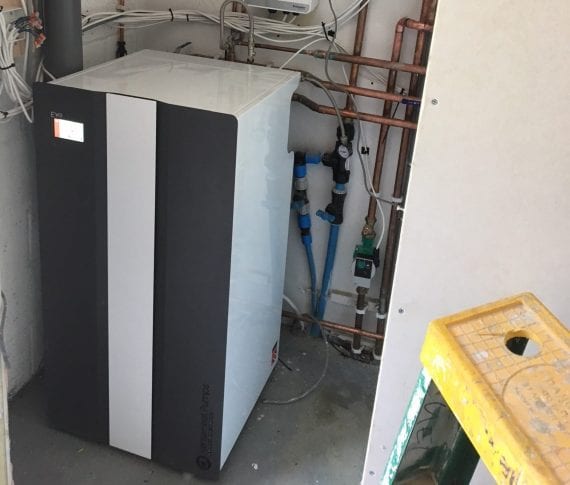
 The project was based in Hatfield, where the customer was renovating and extending their five bedroom 1970s home, to turn it into an ultra-modern living space. The property is actually on mains gas, so the owner deliberately installed a ground source heat pump to be more eco-friendly.
The project was based in Hatfield, where the customer was renovating and extending their five bedroom 1970s home, to turn it into an ultra-modern living space. The property is actually on mains gas, so the owner deliberately installed a ground source heat pump to be more eco-friendly. Having previously fitted the Kensa Twin Compact, I think the new Evo is brilliant! It is very user-friendly, easy to install and commission. The intuitive control panel allows you to see exactly what’s going on and find your way around the heat pump.
Having previously fitted the Kensa Twin Compact, I think the new Evo is brilliant! It is very user-friendly, easy to install and commission. The intuitive control panel allows you to see exactly what’s going on and find your way around the heat pump.
